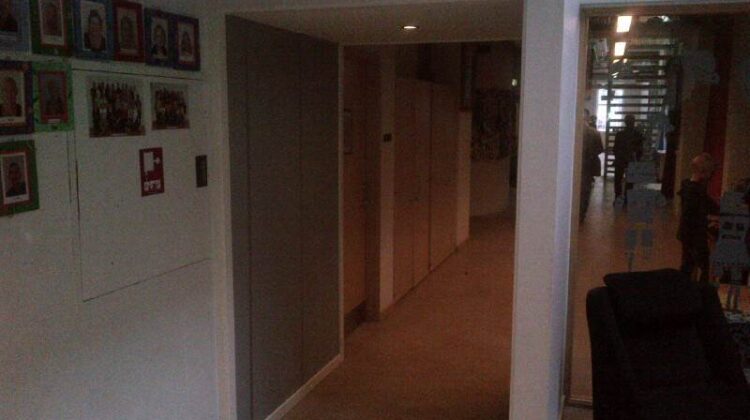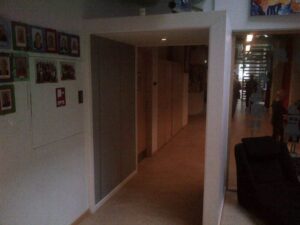

Tumlesalen i Nord Day Care Centre in Copenhagen
Reduction of noise is the priority in Copenhagen in day care centres. Working environment studies show that noise is the primary cause for day care teachers leaving their profession. Copenhagen Municipality have initiated a study to demonstrate how to improve the Day Care sound environment for the future teachers and children.
Every fifth year a work environment and occupational health survey is made by NFA (Danish National Research Centre for the Working Environment). As far back as 2005 day care teachers were top of the list of the professional groups who complained most about noise problems in Denmark. Since then Copenhagen Municipality has had considerable focus on this issue and in 2007, made an internal working environment study for day care centres and the results showed the same noise issues. Furthermore, it showed that noise is the primary cause for day care teachers leaving their profession.
In the same period BUPL (Danish Union of Early Childhood and Youth Educators) published a survey showing that sound levels (LAeq) in day care centres exceed 80 dB(A)! Subsequent to these surveys, Copenhagen Municipality initiated the project ‘Plads til Alle’ (‘Room for Everybody’).
The project.
Three different day care centers were chosen for the project (different type of buildings, different sizes, different organizations), and they all committed to take part of pedagogical, organizational and building changes to test different types of noise control. The teachers took great part in the process to make sure that main focus was on the end users – and they worked really hard initially on the pedagogical and organizational issues which left a lot of time to work on the building changes. The project involved sound insulation, sound absorption and building of new walls and sound tunnels.
Day care centre – ‘Børneborgen’.
Before the building changes Børneborgen had perforated plasterboard ceilings – and actually the reverberation time was close to regulation demands (in DK you have to achieve 0,4 sec. in day care centers). Despite a relatively short Reverberation Time something was not working, the teachers complained about the noise levels and explained that certain rooms were impossible to stay in for more than an hour or two – ex the room ‘Tårnfalken’ where the children go to play computer games. “Lombard Effect”* was in general a big problem in this day care center and even though the teachers tried to organize the room ‘Tårnfalken’ differently and tried to limit the use of computers during the day – the high noise levels were still a problem. It was impossible to solve the noise issues with only pedagogical and organizational changes – and acoustic treatment was found to be the only solution.
Acoustic treatment in ‘Børneborgen’.
The plasterboard ceilings were replaced by Ecophon Master A (40 mm. glass wool) and to absorb horizontal components of the sound field Ecophon Wallpanels were installed. To obtain optimum room acoustic comfort, a freize of Master B (40 mm. glass wool) was installed just below the ceiling. The results were remarkable. Not only did the acoustic treatment lower RT to under 0.4 sec. in all frequency bands – the “Lombard Effect”* was gone! The teachers reported that they could work all day without getting a headache and without telling the kids to keep their voices down.
Reverberation time in room ‘Tårnfalken’

Table: Akustik ApS / Team Arbejdsliv Report
Other results
Besides the day care center ‘Børneborgen’ both ‘Nord’ and ‘Potteskåret’ showed great results – and the acoustician Per Møberg, concluded that neither organizational nor pedagogic changes will help minimizing noise issues if the acoustic treatment of a room is inappropriate or insufficient or if the room simply does not support the activity.
In day care center ‘Potteskåret’ which is an open plan day care center they had to build up new walls – and smaller rooms called ‘cubes’ were acoustically treated with Wallpanels and freizes to lower LAeq. It was also necessary to build so called sound tunnels treated with Wallpanels (Super G) to lower the DL2 values.

Image: Akustik ApS / Team Arbejdsliv Report

The building Potteskåret’ used to be the old Bing & Grøndahl porcelain factory and with respect for its old use and legacy and its unique architecture it was impossible to make suspended ceilings.
Results related to the teachers’ wellbeing were just as remarkable as the acoustical results:
• Short-term sick leave has fallen.
• Fewer employees would like to leave their profession
• Self reported stress decreased from 52% to 25%.
• The percentage of employees who feel annoyed by noise decreased from 63% to 16%
In all, the project clearly concludes that teachers (and children!) in day care centres struggle with noise levels when the acoustic treatment is not good enough. If the wrong material is used or if the treatment is not sufficient it is impossible for the teachers to choose what they would like to do. When the acoustic conditions are bad – the teachers must really choose what is possible to do which is frustrating and one of the reasons why teachers want to leave their profession.
On the contrary when the acoustics is sufficient – when the right materials are chosen, the work environment will be positive, the children’s play does not need to be restricted because of the noise levels and the teachers can perform higher quality work with reduced stress and annoyance.
The “Plads til Alle” / “Room for Everybody” report by Akustik Aps (Per Moberg) and Team Arbejdsliv (Inger-Marie Weigman), can be down loaded in Danish here
* “Lombard Effect” – (Lombard c1911) – Is the general term for the phenomenum and involuntary tendancy when the speaker raises their voice in order to hear themselves above the background noise.
Wikipedia – The Lombard effect or Lombard reflex is the involuntary tendency of speakers to increase their vocal effort when speaking in loud noise to enhance the audibility of their voice.This change includes not only loudness but also other acoustic features such as pitch and rate and duration of sound syllables. This compensation effect results in an increase in the auditory signal-to-noise ratio of the speaker’s spoken words.

